Abstract
Theories on learning styles and types have been integral to discussions on the basics of teaching for nearly 40 years. The learning style typology of Kolb divides learners into four groups (Diverger, Assimilator, Converger and Accomodator), which differ both in terms of their learning behaviour as well as personality and preferences. We studied the sense of coherence and burnout symptoms in medical students of the preclinical semesters (1st to 4th semester) at the Friedrich-Alexander University of Erlangen within the context of the observed learning styles. A total of 530 students were interviewed in winter semester 2012/13 using standardized psychometric questionnaires. Our students showed a significant correlation between the respective learning styles and expression of a sense of coherence, as well as cognitive and emotional burnout symptoms. The learning styles of the students differed significantly within these same parameters. We also demonstrated that learning styles and types not only influence study performance, but that there are also relationships to sense of coherence and psychological ailments. A more forward-looking integration of the theory of learning types in the medical education curriculum could positively influence both the performance and psychological well-being of the students.
Keywords: freshman students, learning types, sense of coherence, burnout, psychological stress
Zusammenfassung
Theorien über Lernstile und Lerntypen sind seit fast 40 Jahren fester Bestandteil lehrdidaktischer Diskussionen. Die Lerntypologie nach Kolb unterteilt Lernende in vier Gruppen (Divergierer, Assimilierer, Konvergierer und Akkomodierer), die sich sowohl hinsichtlich ihres Lernverhaltens als auch ihrer Persönlichkeit und ihrer Präferenzen voneinander unterscheiden. Wir untersuchten den Zusammenhang der vorliegenden Lerntypen mit dem Kohärenzerleben und Burnout-Symptomen bei Humanmedizinstudierenden in der Vorklinik (1.-4. Semester) an der Friedrich-Alexander Universität Erlangen. Insgesamt 530 Studierende wurden von uns im Wintersemester 2012/13 mit standardisierten Selbstbeurteilungsfragebögen hierzu befragt. Im Ergebnis zeigte sich ein signifikanter Zusammenhang zwischen dem jeweiligen Lernstil und der Ausprägung von Kohärenzgefühl, sowie kognitiven und emotionalen Burnout Symptomen. Die Lerntypen der Studierenden unterschieden sich dabei signifikant in denselben Parametern. Wir konnten außerdem zeigen, dass Lernstile und Lerntypen nicht nur die Leistungen im Studium beeinflussen, sondern auch Beziehungen zu Kohärenzgefühl und psychischen Beschwerden bestehen. Eine weitblickendere Einbeziehung der Theorie der Lerntypen in das medizinische Ausbildungscurriculum könnte sowohl die Performanz, als auch das psychische Befinden der Studierenden positiv beeinflussen.
Introduction
In the present study we investigated the collective of students of human medicine in preclinical semesters at the FAU Erlangen. Levels of learning success vary among students despite the basic equivalence of conditions for learning within the university curriculum and the course of studies. This variation reflects individual preconditions such as prior thematic knowledge, motivation, individual skills and processing modes. Learning styles defined using abstracted constructions attempt to record and categorize the relevant personality traits and preferences of learning persons. A number of theoretical models have been developed in recent decades and adapted to use in studies [1], [2], [3]. For our survey we decided to analyse the data using Kolb’s model, since it views learning as a continuing and progressive process in which the learning person first collects, then processes, experiences [1]. Kolb’s model would appear to be particularly well-suited to our research questions since medical students experience multimodal teaching methods to a significant degree, necessitating both concrete and abstract individual integration of study materials. Kolb describes the methods of knowledge acquisition by differentiating four learning styles, active experimentation (AE), reflective observation (RO), concrete experience (CE) and abstract conceptualization (AC), on which basis four learning types (Divergers, Assimilators, Convergers and Accomodators) are defined (see Figure 1 (Fig. 1)). Divergers (feeling and watching) combine concrete experience and reflective observation. They do well in processes that demand a pronounced faculty for individual imagination. They tend to consider concrete situations from multiple perspectives and lean towards a philanthropic outlook. They develop broad cultural interests and often specialize in artistic endeavours. Assimilators (watching and thinking) tend to prefer reflective observation and abstract conceptualization. They excel when it comes to producing theoretical models. With their tendency towards inductive conclusions, they show more interest in things or theories than in people. Convergers (doing and thinking) combine abstract conceptualization and active experimentation. Their strengths are more in evidence when it comes to practical realization of ideas. They make use of hypothetical-deductive reasoning and prefer dealing with inanimate things and theories as opposed to persons. Accomodators (doing and feeling) prefer active experimentation and concrete experience. Their strengths lie more in the direction of fleshing out the realization of activities. Their approach to solving problems is intuitive, employing trial and error. They prefer dealing with persons over inanimate things or theories. Kolb’s model approaches the matter in a way that distinguishes it from other learning style theories, particularly because persons in diametrically opposed positions of the Kolb model (Assimilatory/Accomodators and Convergers/Divergers) can become involved in cognitive conflicts, which may be manifested, for instance, as conflicts between teachers and learners [4].
Figure 1. Presentation of the learning types based on classification in a coordinate system of the learning styles and types acc. to Kolb, a) General diagram for classification of learning styles and types.
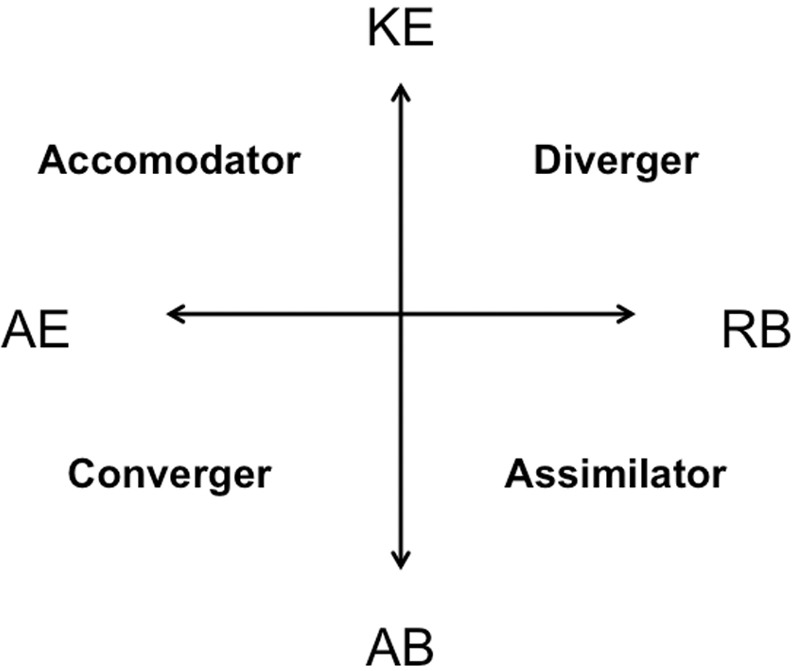
According to Kolb’s investigations, the four learning types differ as to personality and adaptability and usually tend to end up in characteristic professions. In 1984, Kolb analysed the cognitive requirements of such areas as the engineering, social and political sciences, then drew conclusions regarding the interrelations between specific learning types and fields of knowledge. While considering engineers to be mainly Convergers, social and political scientists were seen as mainly Divergers and economists mainly Assimilators. In his opinion, the question remained unsettled whether this type distribution was the result of a selection that had taken place prior to vocational training or a personal development and selection made during the educational and training process [1]. Empirical findings in other investigations support this latter assumption of Kolb [5], [6], [7]. Sports teachers, for example, lean towards active experimentation / concrete experience (AE/CE) in their learning styles, whereas mathematics teachers are more accurately characterized in this respect by the terms reflective observation and abstract conceptualization (RO/AC) [8]. Kolb’s learning typology has been tested in the course of the past 30 years in many collectives in the area of nursing care, in a variety of different student collectives and in physicians undergoing advanced training [9], [10], [11], [12], [13], [14], [15]. These investigations have repeatedly called for more adaptation of the educational process to the learning types of the students involved in order to make learning easier and improve performance levels. To date, however, hardly any initiative has been shown in this direction, to say nothing of implementation in existing curricula. Thus no effort has been made to take the diversity of learning styles into account when medical students begin their course of studies. There has also been very little analysis of possible interrelationships between learning behaviour and psychological stress. It seemed to us logical to conclude that Kolb’s learning diagnostics, which he saw as being very closely related to the personality structure of the learner [8], [16], would also have to affect the psychological well-being of the person involved, and vice-versa. To facilitate a closer study of the matter, we investigated students of human medicine in the first four preclinical semesters (from the beginning of the course of studies to the first state examination) regarding their learning type and selected psychological parameters (sense of coherence, burnout symptoms).
Methods
We investigated a total of 530 students of human medicine from semesters 1-4 in winter semester 2012/13. In the interviewing process we collected, among other information, data relevant to learning style using a 40-item catalogue of questions (10 questions on each learning style - AE, RO, CE, AC). We also used standardized and validated self-assessment questionnaires to investigate sense of coherence and burnout symptoms in the entire study cohort.
Our reason for selecting sense of coherence as a parameter was because – in accordance with Antonovsky’s salutogenic model [17] – it describes an inner feeling of confidence that “... the stimuli deriving from one's internal and external environments in the course of living are structured, predictable and explicable” [18]. In students prior to the 1st state examination, who are in the midst of the transformation from preparatory schooling to university studies and are confronting their potential future profession for the first time, this sense of coherence seemed to us particularly relevant. The Sense of Coherence Scale (used here: the Leipzig short form SOC-L9 [19]) is a well-established psychiatric / psychosomatic diagnostic instrument that has demonstrated high levels of significance when used on data records for depression and anxiety in several studies [20]. Parallel to this, we investigated burnout symptoms in the students that represent direct effects of stress and work overload. The Burnout Screening Scales (BOSS-II) use for assessment represent a self-assessment method of registering subjective and psychological symptoms typical of a burnout syndrome [21]. Two 30-item questionnaires that can be used independently are available. BOSS-II comprises three scales (physical, cognitive and emotional symptoms) with ten items each, covering an assessment period of seven days. This questionnaire can be used in both dimensional diagnostics (symptom quantification) and categorical diagnostics (suspected burnout syndrome). The higher the value obtained, the more pronounced the symptoms are. For burnout diagnostics in this particular collective we decided to use the BOSS-II, since the items appeared highly suited to preclinical medical students. In contrast to other established tools, e.g. the classic Maslach Burnout Inventory (MBI), BOSS-II does not make references to patient/client contact, an experience the students in the first four preclinical semesters in Erlangen are either entirely unfamiliar with or which plays at most a very subordinate role. A positive vote was obtained from the competent Ethics Committee to conduct the study and all participants submitted written declarations of consent to anonymized collection and evaluation of their test results. The statistical analysis program IBM SPSS Statistics, Version 21, was used for statistical evaluation of the collected data. In addition to descriptive statistics for normal distribution as applicable, mean comparisons were also done. Single factor ANOVA analyses were applied for this purpose. Correlation tests were used to gauge the connection between how pronounced the manifestation of the learning style was and burnout symptoms or sense of coherence.
Results
For the 530 participants we determined the learning type based on the level of manifestation of the learning styles in each case and categorized the students accordingly in the four main groups Accomodators (Acc), Convergers (Con), Divergers (Div) and Assimilators (Ass), then added a further axis for neutral students (AccCon, AccDiv, ConAss and DivAss) and completely neutral students (see Figure 2 (Fig. 2), 3 (Fig. 3) and Table 1 (Tab. 1)). To facilitate the assessment process, when calculating the differences between the different learning types we included only participants whose categorization in one of the four main types was unequivocal (see Figure 4 (Fig. 4)).
Figure 2. Presentation of the learning types based on classification in a coordinate system of the learning styles and types acc. to Kolb, b) Classification of our cohort in such a coordinate system.
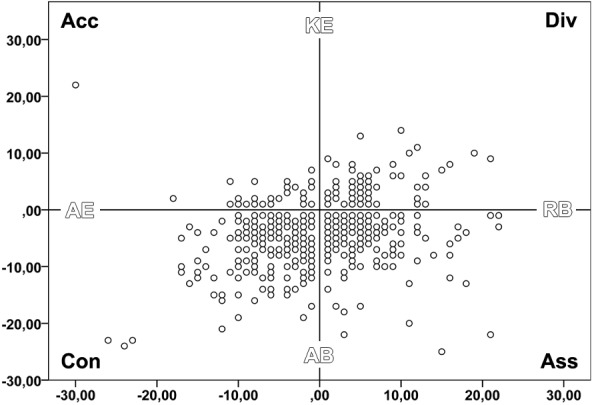
Figure 3. Frequency of the different learning types within the collective, a) All manifestations shown.

Table 1. Frequency of the respective learning types among the medical students (n=530).

Figure 4. Frequency of the different learning types within the collective, b) The four learning types.
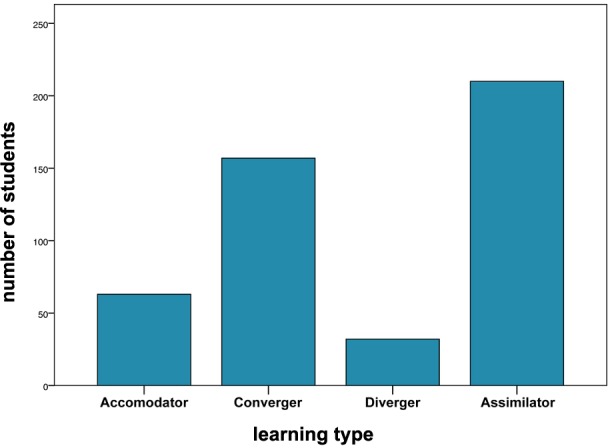
The results revealed clear differences between these four learning types in the sum totals for sense of coherence and burnout symptoms (see Table 2 (Tab. 2) and Figure 5 (Fig. 5)). In the mean comparison of the learning types, this difference was significant for sense of coherence as well as cognitive and emotional burnout (see Table 3 (Tab. 3)). To add focus to our understanding of any potential influences of the learning style components, independent of the resulting learning type, we investigated the influence of the individual sum totals in terms of the learning style scales for the entire collective. This revealed that the students in whom active experimentation was most pronounced scored lowest on the cognitive and emotional burnout scale and highest on the sense of coherence scale.
Table 2. Sense of coherence and burnout syndrome in the respective learning type groups.
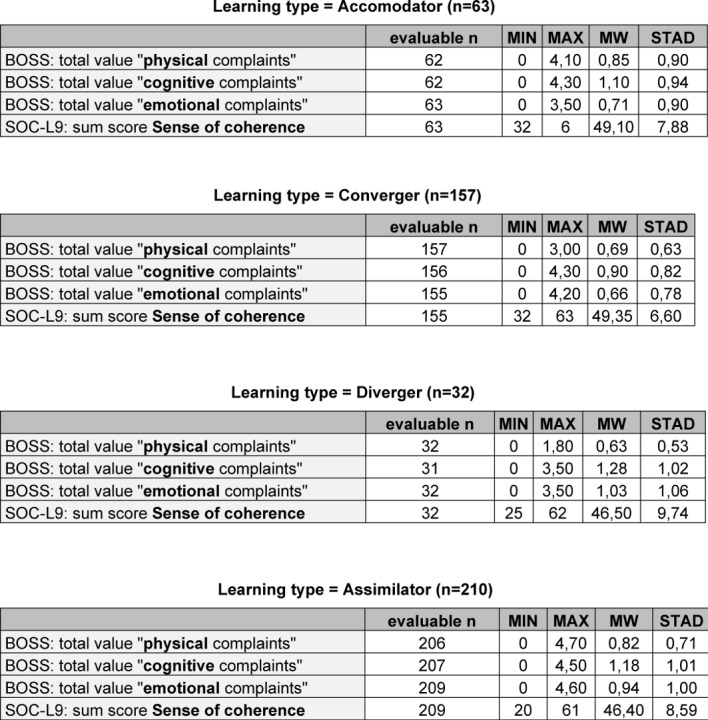
Figure 5. Average level of manifestation of burnout symptoms in the respective learning types.
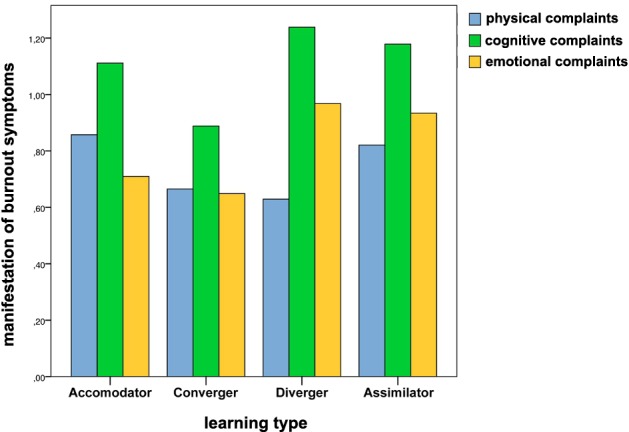
Table 3. Comparison of average sense of coherence and burnout symptoms among the respective learning types (single factor ANOVA).

We also correlated the sum totals of the respective scales with the values obtained for sense of coherence and burnout symptoms. Active experimentation was the only learning style that showed a significant positive correlation with sense of coherence and a significant negative correlation with the cognitive and emotional burnout symptoms (see Table 4 (Tab. 4)). Each of the three burnout values also correlated significantly with the sense of coherence and vice versa.
Table 4. Levels of manifestation of the learning styles (AE, RO, CE, AC) and their correlation with the psychological parameters.

Discussion
In his model, Kolb identified feelings as well as emotional and rational thought processes that influence individual learning styles [22]. The results presented here show, however, that the learning style a person has also influences his or her emotional experience and psychological well-being. In his 2009 publication, Norman called into question the validity of learning style theories and asked whether the knowledge gained from determination of learning styles had a rightful place in practice aimed at knowledge transfer [23]. Even if, as cited by the author, medical students constitute a collective that is highly motivated and capable of high-level performance, and thus potentially well-adapted to a variety of styles of instruction, the results of our study make it very clear that other factors in addition to merely imparting knowledge should be considered when evaluating different learning styles. Kolb’s learning style theory, as shown by our results, could attain to a new level of validity, to a better understanding of successful, or harmful, ways of handling job-related stress. Among the medical students surveyed, an increasing tendency to active experimentation correlated with an increasing sense of coherence. An increased tendency to active experimentation was matched with fewer burnouts. In view of the strong relation between sense of coherence and depression described in the psychiatric literature, one could even be tempted to postulate the protective factor “active experimentation” for this disease. It was interesting to note that none of the other learning styles influenced the psychological parameters, leading to our assumption that, in the curriculum practised at the survey site in Erlangen, the characteristic active experimentation makes a particularly significant contribution to successful mastering of the learning content of the preclinical curriculum. It cannot be stated for certain based on our database to what extent this insight might be applicable to other universities and their curricula: The FAU Erlangen has a classic curriculum with practically no clinical courses in the first semesters. On the other hand it would seem likely that this factor might be even more effective in curricula with different designs (for example PBL-based). Interestingly enough, there appears to be no connection between learning style and the physical burnout symptoms, although this correlates in some ways with our insights into the development of mental illnesses in medical students. Despite the rising prevalence of depression and the drop-off in mental quality of life during the course of studies in students of human medicine, the self-assessments of physical quality of life and physical burnout were constant throughout [24]. Physical condition appears to maintain a constant level throughout the course of studies, regardless of learning type and independent of the factor “medical studies”.
Regarding cognitive and emotional burnout symptoms, a mean comparison between the learning types does, however, reveal a significant difference. This adds to the existing debate on the influence of learning styles on satisfaction [25] and performance of students [26], [27] the factors of mental capacity and sense of well-being, as we had conjectured. It would certainly also be interesting to assess the psychological factors in settings in which the matter of learning types had been previously addressed. For example, how would the sense of coherence in students be characterized if, using Sandmire’s approach [28], each team would always include both a concrete and an abstract learner? In addition to improvements in individual performance levels, would the students then also benefit psychologically – for example due to a broadening of shared understanding of relevant thematic aspects resulting from different kinds of learning experience? Empirical answers to these questions are a task for the future. What can be expected is that helpful learning styles can and will develop over time based on the demands of education and advanced training, which developments may also reveal positive influences of other learning styles as well [9], [14]. Nonetheless, a conscious effort should certainly be made to improve the focus on students’ needs within the framework of training in medical didactics. While there is some evidence that the type of courses offered (the curriculum format) does not necessarily influence students’ learning style [29], broadening the curricular range to include different teaching styles might nevertheless address the different needs of individual students more effectively, at the same time increasing the enjoyment and lowering the stress levels involved in their studies and contributing to a more positive basic attitude towards the acquisition of knowledge.
In future we plan to extend our surveys to include professional ingénues in other medical and nursing fields with the intended focus on helpful learning styles within specific curricular formats, our assumption being that there are extreme differences in the way learning content is conveyed in the different fields. We also intend to collect data at different sites. Processing of additional data and development of concrete offerings based on the results should further improve consideration of the needs of the various types of students. Of course it is only prudent to add here that leaning styles are scientific constructions, whereby individual application of learning styles varies according to context, contents, assigned tasks and institutional aspects and is also changed by the learning and experiential processes themselves. A frequently observation is also that self-assessment of one’s own learning style in learning style inventories often does not coincide with the learning style actually employed. Nistor & Schäfer address this phenomenon as a “task-induced” learning style [30]. Despite these caveats, defined learning styles can be helpful when it comes to designing learning scenarios and learning environments. The objective should be to make education more understandable, easier to grasp and experience in meaningful ways, and to provide psychological support to students that will help them master the demands made on them, both by their universities and their future professions.
Acknowledgement
The authors would like to thank Mr. Michael Beall for editing the English text.
Competing interests
The authors declare that they heve no competing interests.
References
- 1.Kolb D. Experiential learning: experience as the source of learning and development. Eaglewood Cliffs (NJ): Prentice-Hall Inc.; 1984. [Google Scholar]
- 2.Honey P, Mumford, A . The Manual of Learning Styles. Berkshire: Maidenhead; 1992. [Google Scholar]
- 3.Felder RM, Henriques ER. Learning and Teaching Syles in Foreign and Second Language Education. Foreign Lang Ann. 1995;28(1):21–31. doi: 10.1111/j.1944-9720.1995.tb00767.x. Available from: http://dx.doi.org/10.1111/j.1944-9720.1995.tb00767.x. [DOI] [Google Scholar]
- 4.Gabriel A, Haller HD. Untersuchungen zu Lernstilen von Erwachsenen an Abendgymnasien. In: Gabriel A, Haller HD, editors. Festschrift "10 Jahre Abendgymnasium Göttingen". Göttingen: Abendgymnasium Göttingen; 1983. pp. 11–20. [Google Scholar]
- 5.Bremer C. Virtuelles Lernen in Gruppen: Rollenspiele und Online-Diskussionen und die Bedeutung von Lerntypen. In: Scheuermann F, editor. Campus 2000. Lernen in neuen Organisationsformen. Münster: Waxmann; 2000. pp. 135–148. [Google Scholar]
- 6.Kolodzey A. Lernen in virtuellen Umgebungen und Lerntypen. Evaluation zweier problemorientierter vitueller Seminare unter Berücksichtigung des Lerntyps der Lernenden. Magisterarbeit an der LMU München. München: LMU München; 2002. [Google Scholar]
- 7.Schäfer M. Lernstile und e-Learning: Entwicklung und Erprobung eines Kategoriensystems zur Analyse von Lernstilen in problemorientierten virtuellen Seminaren. Wuppertal: Universität Wuppertal; 2004. [Google Scholar]
- 8.Kolb A, Kolb D. The Kolb Learning Style Inventory-Version 3. 1. LSI Technical Manual. Boston, London: Hay Resources Direct; 2005. Available from: http://www.whitewater-rescue.com/support/pagepics/lsitechmanual.pdf. [Google Scholar]
- 9.Adesunloye BA, Aladesanmi O, Henriques-Forsythe M, Ivonye C. The preferred learning style among residents and faculty members of an internal medicine residency program. J Natl Med Assoc. 2008;100(2):172–175. doi: 10.1016/s0027-9684(15)31205-0. [DOI] [PubMed] [Google Scholar]
- 10.Baker JD, Reines HD, Wallace CT. Learning style analysis in surgical training. Am Surg. 1985;51(9):494–496. [PubMed] [Google Scholar]
- 11.Cavanagh SJ, Hogan K, Ramgopal T. Student nurse learning styles. Sr Nurse. 1994;14(1):37–41. [PubMed] [Google Scholar]
- 12.Cavanagh SJ, Hogan K, Ramgopal T. The assessment of student nurse learning styles using the Kolb Learning Styles Inventory. Nurse Educ Today. 1995;15(3):177–183. doi: 10.1016/S0260-6917(95)80103-0. Available from: http://dx.doi.org/10.1016/S0260-6917(95)80103-0. [DOI] [PubMed] [Google Scholar]
- 13.D'Amore A, James S, Mitchell, EK Learning styles of first-year undergraduate nursing and midwifery students: a cross-sectional survey utilising the Kolb Learning Style Inventory. Nurse Educ Today. 2012;32(5):506–515. doi: 10.1016/j.nedt.2011.08.001. Available from: http://dx.doi.org/10.1016/j.nedt.2011.08.001. [DOI] [PubMed] [Google Scholar]
- 14.Engels PT, de Gara C. Learning styles of medical students, general surgery residents, and general surgeons: implications for surgical education. BMC Med Educ. 2010;10:51. doi: 10.1186/1472-6920-10-51. Available from: http://dx.doi.org/10.1186/1472-6920-10-51. [DOI] [PMC free article] [PubMed] [Google Scholar]
- 15.Zoghi M, Brown T, Williams B, Roller L, Jaberzadeh S, Palermo C, McKenna L, Wright C, Baird M, Schneider-Kolsky M, Hewitt L, Sim J, Holt TA. Learning style preferences of Australian health science students. J Allied Health. 2010;39(2):95–103. [PubMed] [Google Scholar]
- 16.Mainemelis C, Boyatzis R, Kolb D. Learning Styles and Adaptive Flexibility: Testing Experiential Learning Theory. Manag Learn. 2002;33(5):5–33. doi: 10.1177/1350507602331001. Available from: http://dx.doi.org/10.1177/1350507602331001. [DOI] [Google Scholar]
- 17.Antonovsky A. The structure and properties of the sense of coherence scale. Soc Sci Med. 1993;36(6):725–733. doi: 10.1016/0277-9536(93)90033-z. [DOI] [PubMed] [Google Scholar]
- 18.Singer S, Brähler E. Die "Sense of Coherence Scale" Testhandbuch zur deutschen Version. Göttingen: Vandenhoeck & Ruprecht GmbH & Co KG; 2007. [Google Scholar]
- 19.Schumacher J, Wilz G, Gunzelmann T, Brahler E. The Antonovsky Sense of Coherence Scale. Test statistical evaluation of a representative population sample and construction of a brief scale. Psychother Psychosom Med Psychol. 2000;50(12):472–482. doi: 10.1055/s-2000-9207. Available from: http://dx.doi.org/10.1055/s-2000-9207. [DOI] [PubMed] [Google Scholar]
- 20.Burger PH, Tektas OY, Paulsen F, Scholz M. From freshmanship to the first "Staatsexamen" - increase of depression and decline in sens of coherence and mental quality of life in advanced medical students. Pschother Psychosom Med Psychol. 2014;64(8):322–327. doi: 10.1055/s-0034-1374593. Available from: http://dx.doi.org/10.1055/s-0034-1374593. [DOI] [PubMed] [Google Scholar]
- 21.Hagemann W, Geuenich K. BOSS - Burnout-Screening-Skalen. Göttingen: Hogrefe Verlag; 2009. [Google Scholar]
- 22.Suliman WA. The relationship between learning styles, emotional social intelligence, and academic success of undergraduate nursing students. J Nurs Res. 2010;18(2):136–143. doi: 10.1097/JNR.0b013e3181dda797. Available from: http://dx.doi.org/10.1097/JNR.0b013e3181dda797. [DOI] [PubMed] [Google Scholar]
- 23.Norman G. When will learning style go out of style? Adv Health Sci Educ Theory Pract. 2009;14(1):1–4. doi: 10.1007/s10459-009-9155-5. Available from: http://dx.doi.org/10.1007/s10459-009-9155-5. [DOI] [PubMed] [Google Scholar]
- 24.Scholz M, Neumann C, STeinmann C, Hammer CM, Schröder A, Eßel N, Paulsen F, Burger PH. Development and Correlation of Work-related Behavior and Experience Patterns, Burnout and Quality of Life in Medical Students from their Freshmanship to the First State Examination. Psychother Psychosom Med Psychol. 2014 doi: 10.1055/s-0034-1375630. [DOI] [PubMed] [Google Scholar]
- 25.Gurpinar E, Alimoglu MK, Mamakli S, Aktekin M. Can learning style predict student satisfaction with different instruction methods and academic achievement in medical education? Adv Physiol Educ. 2010;34(4):192–196. doi: 10.1152/advan.00075.2010. Available from: http://dx.doi.org/10.1152/advan.00075.2010. [DOI] [PubMed] [Google Scholar]
- 26.Lynch TG, Woelfl NN, Steele DJ, Hanssen CS. Learning style influences student examination performance. Am J Surg. 1998;176(1):62–66. doi: 10.1016/S0002-9610(98)00107-X. Available from: http://dx.doi.org/10.1016/S0002-9610(98)00107-X. [DOI] [PubMed] [Google Scholar]
- 27.Sandmire DA, Vroman KG, Sanders R. The influence of learning styles on collaborative performances of allied health students in a clinical exercise. J Allied Health. 2000;29(3):143–149. [PubMed] [Google Scholar]
- 28.Sandmire DA, Boyce PF. Pairing of opposite learning styles among allied health students: effects on collaborative performance. J Allied Health. 2004;33(2):156–163. [PubMed] [Google Scholar]
- 29.Cahill R, Madigan MJ. The influence of curriculum format on learning preference and learning style. Am J Occup Ther. 1984;38(10):683–686. doi: 10.5014/ajot.38.10.683. Available from: http://dx.doi.org/10.5014/ajot.38.10.683. [DOI] [PubMed] [Google Scholar]
- 30.Nistor N, Schäfer M. Lernen mit Stil: Empirische Befunde und offene Fragestellungen zur Bedeutung der Lernstile in virtuellen Seminaren. In: Carstensen D, Barrios B, editors. Campus 2004. Kommen die digitalen Medien in die Jahre? Münster: Waxmann; 2004. [Google Scholar]


